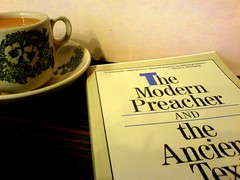The Danger of Anthropocentric Preaching of Old Testament Narratives
Here's Sidney Greidanus in "The Modern Preacher and the Ancient Text", on the dangers of man-centered interpretations of Old Testament narratives (which tend to lend themselves to this sort of abuse):
Old Testament Narratives: Theocentric Narratives with a Theocentric Purpose
More crucial for narrative than for any other genre is the question, What does God here reveal about himself? The reason why this question is so crucial for narrative should be plain: in no other genre does the attention so easily drift from the theocentric focus of Scripture to human beings.What then does purely God-centered/theocentric narrative and interpretation look like?
The Slide into Anthropocentric Preaching
Reasons for anthropocentric preaching are not hard to find. In biblical narrative the human characters frequently appear to be center stage. Moreover, it is so easy in preaching simply to relate the story of Joseph and his brothers, of Ehud and Eglon, of David and Bathsheba, and draw a few "lessons" for the contemporary congregation. It is somewhat understandable that busy preachers fall into the trap of preaching anthropocentric sermons from time to time; what is less understandable is that homileticians, presumably after giving it some thought, would advocate this approach. A quotation from [two such homilecticians] will clarify the point at issue:Another effective type of expository preaching is that of preaching on Bible characters. Faris D Whitesell, in his excellent book on this subject [Preaching on Bible Characters], gives many reasons for placing this type of preaching in high priority. He points out that this is perhaps the easiest way to preach the Bible, the most likely to appeal to people and to hold their attention…and the most likely to be remembered. And, for freshness and variety, there are approximately four hundred Bible characters from which to choose. (CW Keller, "Expository Preaching without Notes")Similar advice can be found in many homiletics texts. The question is, however, if such an anthropocentric approach does justice to the Scripture. Marten Woudstra, for one, observes that "the aim of biblical historiography is not to focus on the human agents of the redemptive drama, or to exploit their good and evil deeds for purposes of moral example or deterrent". Woudstra points to Joshua 24 as an illustration of "how sacred history must be viewed": "Throughout this summary the emphasis is on what God, the covenant Lord, has done. It is this emphasis, not that of moral example, that causes the people to respond with an expression of loyalty to their Lord and demonstrate their willingness to serve only him".
For permanent collection of Biblical material, buy two cheap Bibles and clip out all the passages related to this character. Paste them together in chronological sequence… The keyword for the sermon will be "characteristics", "traits", or some such word… In the sermon, be sure to take the character off the pedestal by finding those traits that are relevant and most practical for the listener…
[Example]
Sermon from the life of Jonathan
I. Courage – 1 Samuel 14:6
II. Humility – 1 Samuel 18:4
III. Loyalty – 1 Samuel 19:2
(Perry, "Manual for Biblical Preaching")
Sometimes preachers, sensing the deficiency of straight anthropocentric preaching, will try to do justice to both God and human characters as two distinct factors in the text. This procedure often leads to a curious split in the sermon between a theocentric explication and an anthropocentric application. In historical narrative, however, it is no a question of two opposite factors which must each receive their due, but rather one "factor", God, who works for, through, and sometimes in spite of people. God, after all, is the God who makes covenants with people. In the covenant history narrated in the Bible, the human characters appear not for their own sake but for the sake for showing what God is doing for, with, and through them. As von Rad puts it in connection with Genesis 16 (Hagar and Ishmael), "There can be no doubt that the story in no way intends to provide us with examples…The sermon must be careful…to treat not of human affairs but of God's gracious ways of dealing with men".
Old Testament Narratives: Theocentric Narratives with a Theocentric Purpose
Labels: 1 Samuel








0 Comments:
Post a Comment
Subscribe to Post Comments [Atom]
<< Home